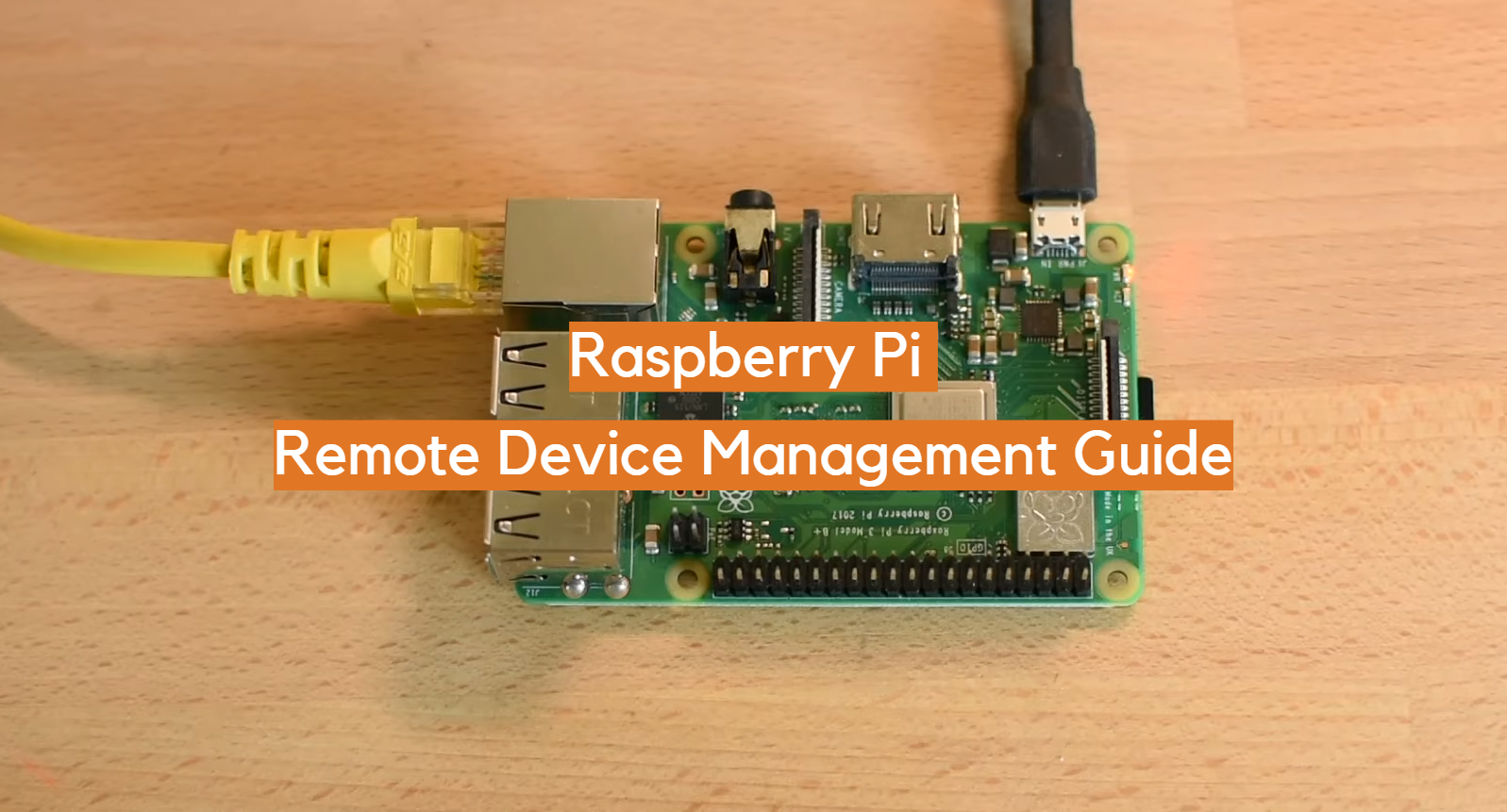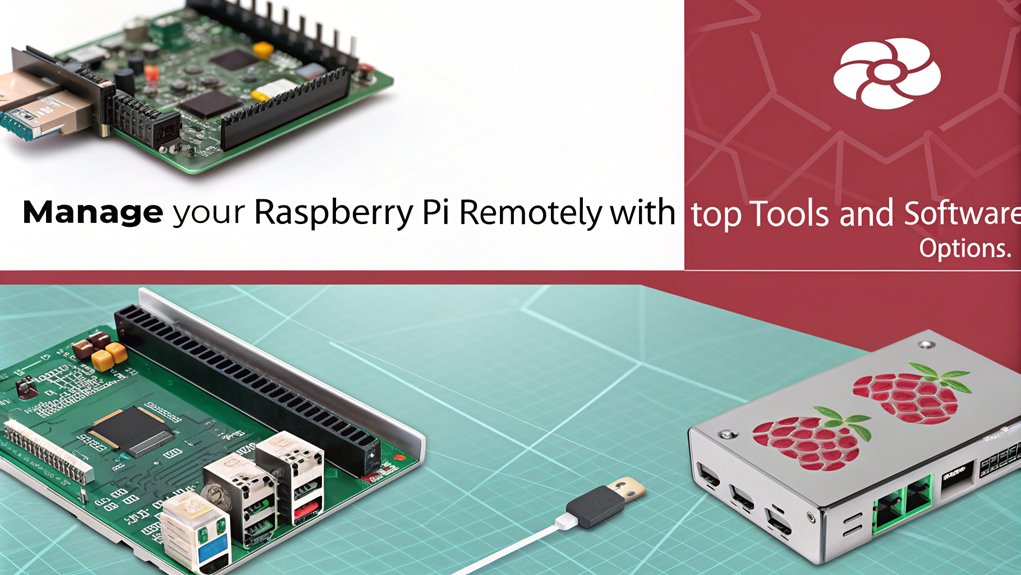Raspberry Pi Remote Manage
Is it possible to control a Raspberry Pi from anywhere in the world, accessing its power and functionality as if it were right in front of you? The answer, unequivocally, is yes. The ability to remotely manage a Raspberry Pi is not just a possibility; it's a practical reality that unlocks a vast potential for automation, monitoring, and control. This capability, often overlooked, transforms the tiny computer into a versatile tool capable of extending its reach far beyond the confines of a local network.
The concept of "raspberry pi remote manage" encompasses a range of techniques and tools, all designed to facilitate the control and monitoring of a Raspberry Pi device from a distant location. This can be achieved using secure shell (SSH) connections, virtual network computing (VNC), or even more sophisticated cloud-based solutions. The specific approach chosen will often depend on the user's technical expertise, the security requirements, and the intended application. From home automation systems and remote data logging to headless server management and interactive educational projects, the applications are remarkably diverse. The key lies in understanding the fundamental principles of remote access and applying them to the specific needs of the project.
This article explores the core aspects of raspberry pi remote management, providing an in-depth look at the methods, tools, and best practices required for secure and efficient remote operation. The goal is to provide a comprehensive guide, empowering readers to leverage the full potential of their Raspberry Pi devices regardless of their physical location.
Lets delve into the practicalities of establishing remote access. The initial step often involves configuring the Raspberry Pi to accept remote connections. This usually means enabling SSH, which allows for secure command-line access. Additionally, the user might opt to set up a VNC server to provide a graphical desktop environment that can be accessed remotely. Port forwarding, a critical concept, allows incoming traffic from the internet to be directed to the Raspberry Pi on the local network. Security, of course, is paramount, and measures such as strong passwords, key-based authentication, and regular software updates are indispensable. Firewall configuration and intrusion detection systems can further harden the system against potential threats. Understanding these fundamentals is vital before embarking on any remote management endeavor.
Beyond the basic setup, there are a number of advanced techniques and tools that expand the capabilities of raspberry pi remote management. Cloud-based services offer streamlined remote access and management interfaces. VPNs (Virtual Private Networks) create secure tunnels, allowing the Raspberry Pi to be accessed as if it were part of the local network. Reverse proxies are able to provide access to internal services without directly exposing them to the internet. Containerization technologies, such as Docker, can simplify application deployment and management. The choice of advanced techniques will depend on the project's complexity, security requirements, and performance considerations. The user is equipped with several choices, and knowing which technique is needed will provide a stronger grasp on the task.
For those unfamiliar with the Raspberry Pi, it's important to understand its basic capabilities. The Raspberry Pi is a credit-card-sized computer that can be used for a variety of purposes. It's low cost and versatility have made it popular among both hobbyists and professionals. Running on Linux, the Raspberry Pi can be used for everything from media centers to home automation servers. Its ability to connect to the internet is crucial for remote access. The Raspberry Pi's architecture allows for easy expansion with a multitude of peripherals, making it suitable for a wide range of remote management applications. The very nature of the Raspberry Pi, small, adaptable, and capable, is what makes it so ideally suited for remote management applications. It is a device that can be controlled from anywhere in the world, given the correct setup, opening up a whole world of possibilities.
Let us illustrate the power of "raspberry pi remote manage" with a few real-world scenarios. Imagine a home owner monitoring their home's security system from a remote location, checking camera feeds, and receiving alerts about any unusual activity. Consider a scientist collecting data from sensors deployed in a remote area, analyzing the information without having to travel to the site. Or, picture an educator running a coding class from a distance, guiding students through programming exercises on their Raspberry Pi devices. These are just a few of the many possibilities that open when remote management capabilities are leveraged. The ability to control a device from afar is often more than just a convenience; it is the critical factor that allows some projects to even be possible.
Consider the example of a "headless" Raspberry Pi server. This is a setup where the device operates without a connected monitor, keyboard, or mouse. Instead, all management is performed remotely, using SSH or VNC. The headless setup is ideal for servers performing background tasks, such as hosting websites, file storage, or running automation scripts. Setting up a headless system requires specific steps: configuring the network, enabling SSH, and potentially setting up VNC for remote desktop access. It is a powerful configuration for those who want to put the Raspberry Pi to use in tasks that may not require constant monitoring. Such a setup is not only space-efficient but also conserves resources, making it perfect for embedding Raspberry Pi into projects where size and energy consumption are of concern.
When setting up remote access, security is paramount. Weak passwords are a primary vulnerability. Using strong, unique passwords, and changing them regularly, is crucial. Two-factor authentication, if supported, adds an extra layer of protection. Keeping the Raspberry Pi's software up to date with the latest security patches helps to protect against known vulnerabilities. Firewalls can filter incoming and outgoing network traffic, preventing unauthorized access. Implementing these measures, a network administrator can greatly reduce the risk of a security breach. The potential vulnerabilities of any network system should be constantly considered, and all necessary actions taken to minimize those risks. Remote access, while powerful, does carry an associated risk.
Another critical aspect of raspberry pi remote manage is understanding networking concepts, especially those related to the internet. Knowing the difference between public and private IP addresses, how port forwarding works, and the role of a router are essential. To access your Raspberry Pi from outside your home network, you'll need to configure your router to forward traffic on specific ports (usually port 22 for SSH and port 5900 for VNC) to the Raspberry Pi's local IP address. Dynamic DNS services can provide a stable hostname, which is helpful because your public IP address may change. Testing the connection, and ensuring it works as intended, is essential. The user needs to have a reasonable level of understanding of network to correctly set up remote access.
The performance of remote management is greatly influenced by network connectivity. A stable, high-bandwidth internet connection is crucial for a smooth user experience. The speed of your home network, both wired and wireless, affects how responsive the remote interface will feel. For instance, when using VNC, slow network speeds can lead to lag and a sluggish experience. Consider optimizing the VNC settings, such as reducing the color depth or using a lower screen resolution, to improve performance over a slower connection. Remote access is only as reliable as the network itself. Any interruptions to the network, whether intentional or unintentional, can greatly impact the effectiveness of remote access.
Tools such as SSH (Secure Shell) provide secure command-line access to the Raspberry Pi. With SSH, you can execute commands, manage files, and perform system administration tasks remotely. VNC (Virtual Network Computing) offers a graphical desktop environment, allowing you to interact with the Raspberry Pi as if you were physically present. Cloud-based services offer a user-friendly interface and may simplify remote access. These services often have features such as automatic updates, security monitoring, and remote backups. Choosing the right tool depends on your individual needs, level of technical expertise, and the requirements of the project.
One of the most important aspects of "raspberry pi remote manage" is its impact on the accessibility and convenience of using the Raspberry Pi. The ability to manage your Raspberry Pi from anywhere simplifies many tasks. For instance, setting up and maintaining servers, running remote education sessions, or monitoring environmental sensors becomes significantly easier. It allows the user to access their system from anywhere they have an internet connection. This leads to increased productivity, greater flexibility, and a significant saving of time. This is the key benefit of all remote access systems: the ability to remove the need to be present physically.
Troubleshooting is an important aspect of "raspberry pi remote manage". Common issues include network connectivity problems, incorrect SSH configuration, and VNC server issues. Use online resources such as forums and documentation for help. Double-check IP addresses, ports, and firewall settings. Verify the status of services, and examine log files for error messages. Careful troubleshooting is critical for diagnosing and resolving issues. With enough persistence and the right tools, even the most difficult remote management problems can be solved. Patience and diligence are keys to successful remote management, especially if problems arise.
Looking to the future, the possibilities of raspberry pi remote manage are likely to grow, fueled by increased internet access, higher network speeds, and the continued development of user-friendly management tools. The Internet of Things (IoT) will likely drive demand for remotely manageable devices, and the Raspberry Pi will continue to play a significant role in IoT deployments. As technology evolves, remote management will become more secure, easier to use, and more powerful. The future of remote management promises to unlock more possibilities for innovation and convenience.
In summary, "raspberry pi remote manage" transforms the Raspberry Pi into a truly versatile tool. It provides the ability to manage the device from a distance, opening up a range of opportunities from home automation and remote data logging to educational projects and server management. Through careful configuration and the implementation of secure methods, the user can unlock the full potential of the Raspberry Pi.
Here is a table that contains some of the essential data related to the subject.
| Aspect | Details |
|---|---|
| Key Concepts | SSH (Secure Shell), VNC (Virtual Network Computing), Port Forwarding, Dynamic DNS, VPN, Cloud-Based Services. |
| Methods of Access | Secure Shell (SSH): Command line access. Virtual Network Computing (VNC): Graphical Desktop Access. Cloud-Based Solutions: User-friendly interface for remote management. |
| Security Considerations | Strong Passwords, Two-Factor Authentication, Regular Software Updates, Firewall Configuration, Intrusion Detection Systems. |
| Troubleshooting | Network Connectivity, Incorrect SSH Configuration, VNC Server issues, checking IP address, ports and firewall settings. |
| Benefits | Remote monitoring and control of devices, reduced travel, access to systems from anywhere, increased productivity, and more. |
| Applications | Home Automation, Remote Data Logging, Server Management, Headless Operation, Educational Projects, IoT deployments. |
| Essential tools | Raspberry Pi, Router, Computer, Internet Connection. |



